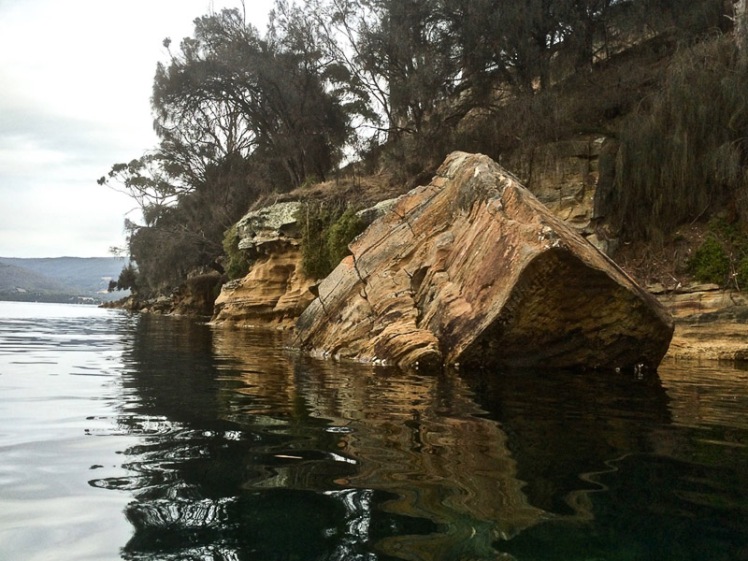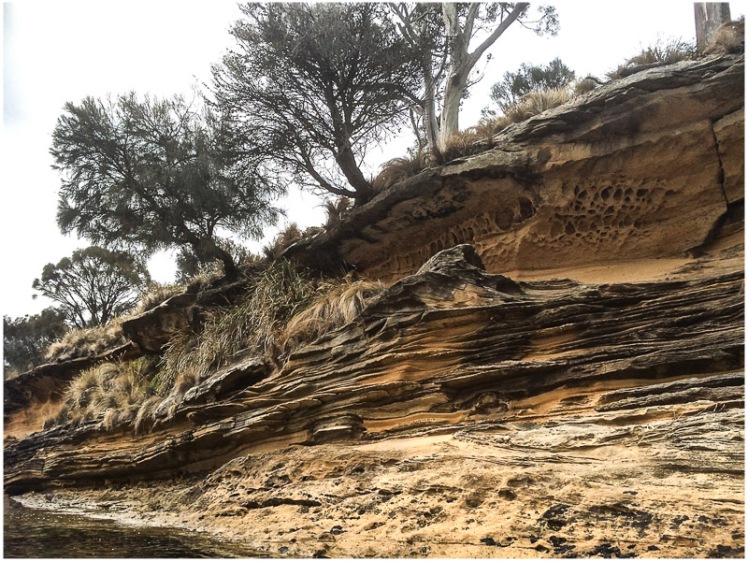D’Entrecasteaux Channel: North West Bay: the NE reaches
Continuing the Journey Around Ranggoerrade: Heading for Dru Point

Dangerous Encounters with Gulls
I drifted out of Stinkpot Bay and paddled north. As I approached a corrugated metal boat shed the ‘owner’, a seagull, flew above me, screaming warnings, while using a novel approach to keep me at bay. Not wanting to take a direct hit, its missiles hitting the water beside my kayak, I paddled around the point, somewhat aghast, aware that the alarm had now been taken up by two plovers, who joined in the shrieking then quickly shot off, careful not to fly beneath the heavily loaded gull.

Birds of the North East Corner
The bay shallows out up here and I found myself in just a few inches of water . When the tide is out, I figured, this would be an expansive stretch of muddy sand but it was tricky to determine whether it really constituted a beach. I floated past Villa Howden, just visible between trees. Three pied oyster catchers were hanging out on a rock, and I was kayaking like a handfish, my paddle useless now because it was so shallow. If I’d had to get out I’d have sunk into the unforgiving mud.

Then I was back along cliffs, different layers of rocks sandwiched on top of each other, a little unconsolidated, and the water a little deeper now so that I could go closer in. Three pied oyster catchers, presumably the three from earlier, were now lazing companionably on a slipway and a cormorant was snoozing on a buoy close by. One of them emitted cautious alarm calls about my arrival* for the cormorant’s benefit and I watched her rouse herself and start looking around frantically as I floated by, not conscious of my presence. Still unable to determine the danger, she departed in a rush anyway, but the oyster catchers, calculating my progress, followed in a more leisurely fashion a while later.
I was ready to turn west. The beautiful serenity dissipated because I was close to the Channel Highway. There were paddocks and then Margate itself, but the shape of the watery world was entrancing, full of rushy islets separated by shallow channels and in them the water was still.

I took a punt on the third channel, heading along with my rudder up and spotted the North West River entering the bay. I’d walked to about this point in the virtual company of my sister several days earlier, and from her different continent she’d enthusiastically told me discomforting stories of misadventure that had me looking over my shoulder as I navigated the lonely muddy shoreline beneath the park’s deserted cliffs.
On that day that I walked with my sister’s voice in my hand, I’d passed the playground, walking along a tendril of beach sand and then along dark cobbles with oysters glued to their sides and then along stretches of succulent salt marsh.

I’d negotiated exposed rocks in dark mud and heard a chorus of tiny noises that I think came from the invertebrates living down muddy tunnels, and I’d seen a grey heron, no doubt one of the two I’d been watching on this kayaking trip.
I’d expected to see a vibrant range of birds from my kayak but even in the less well frequented parts of the bay this was not the case. Seagulls were the most prolific; I saw twelve, but no sign of the penguins that hopefully still inhabit the bay.
The water beyond the river mouth was glassy and a whole lot deeper in these tussocky channels. I encountered three pairs of black swan and two pelicans (probably the same ones I’d met on my walk) and then I turned south west to head around Dru Point. A lone pied oyster catcher watched me go by.
The heron reappeared while I was kayaking briskly over more oyster laden reefs. There were people near the jetty and the boat slip and the sea breeze had just begun arriving. I made a dash through the moorings and raced along to my arrival point, the most western beach along the Dru Point road, a muddy little thing frequented by ducks.

Although I was stoked and keen to continue the geo had the final say: ‘Enough,’ he said. ‘You can kayak the rest another day. ‘ It seemed a reasonable request. The trip had been sublime. It had taken four hours, but had felt like only one. I just wasn’t sure when I’d get another chance to come paddling on Ranggoeradde.
*I try to adhere to ethical birdwatching guidelines.








